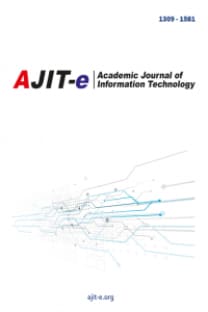İHSAN KARLI, Yusuf BUDAK, Özhan TINGÖY, Mustafa CANKUT KURT, International Advisory BOARD, Abdurrahman Arslanyilmaz OHİO, ALİ ÖZCAN
Owner/Editor in Cheef Board
Dergide yayınlanan yazılardaki görüşler ve bu konudaki sorumluluk yazarlarına aittir. Yayınlanan eserlerde yer alan tüm içerik kaynak gösterilmeden kullanılamaz. All the opinions written in articles are under responsibilities of the outhors. The published contents in the articles cannotbe used without being cited
International Advisory Board Prof. Dr. Ian Ruthven (University of Strathclyde, İskoçya) Prof. Dr. David Benyon (Edinburg Napier University, İskoçya) Prof. Dr. Ümit S. Bititci (Heriot Watt University, Edinburgh, İskoçya) Prof. Dr. Ayşe Göker, (Robert Gordon University, Aberdeen, UK) Prof.Dr. Angappa Gunasekaran (Charlton College of Business, University of Massachusetts, ABD) Prof. Amjad Hadjikhani (Uppsala Universitet/Uppsala/İsveç) Prof.Dr. Azmuddin İbrahim (Unisel Universiti/Selangor/Malezya) Prof. Dr. Adrian Cross (University of Strathclyde, İskoçya) Dr. Charalambos Tsekeris (Panteion University of Social and Political Sciences, Atina, Yunanistan) Dr. David Fernández-Quijada (Universitat Autònoma de Barcelona, İspanya) Doç.Dr. İsmet Anıtsal (Tennessee Tech University, ABD) Doç.Dr. Maria Manuela Cruz-Cunha (Polytechnic Institute of Cávado e Ave, School of Technology/Portekiz) Doç. Dr. S.A.M.Pasha (Jamia Millia Islamia/Malezya) Doç. Dr. Anvarjon Ahmedov (Universiti Putra/Malezya) Doç. Dr. Mumtaz AL-Mukhtar (AL-Nahrain University/Bagdat/Irak) Yrd. Doç. Dr. M. Meral Anıtsal (Tennessee Tech University, ABD) Yrd. Doç.Dr. Abdurrahman Arslanyilmaz (Ohio, ABD) Dr. Man-Ki MOON (Chung-Ang University/Seul/South Korea) Dr. Tim Marsh (James Cook University/Avusturalya)
___
- Awokuse, T. O. (2003), Is the Export-led Growth Hypothesis Valid for Canada? Canadian Journal of Economics/Revue canadienne d'économique, 36, 126–136.
- Balassa, B. (1978). “Exports and Economic Growth: Further Evidence”, Journal of Development of Economics, 5, 181-189.
- Bbaale, E. and Mutenyo, J. (2011), “Export Composition and Economic Growth in SubSaharan Africa: A Panel Analysis”. Consilience: The Journal of Sustainable Development. 6, 1–19.
- Bhagawati, J. N. (1982) “Directly Unproductive Profit Seeking (DUP) Activities”, Journal of Political Economy, 90, (5), 988–1002.
- Cuaresma, J. C., & Wörz, J. (2005). On export composition and growth. Review of World Economics, 141(1), 33-49.
- Dreger and Hezer (2013), “A Further Examination of the Export-led Growth”, Empirical Economics, 45: 39-60
- Dunusinghe, P. (2009), “On Export Composition and Growth Evidence from Sri Lanka”. South Asia Economic Journal, 10 (2), 275-304
- Eichengreen, B., Donghyun, P., Kwanho S., (2013), “Growth Slowdowns Redux: New Evidence on the Middle-Income Trap”, NBER Working Paper 18673
- Fagerberg, J. (1994). Technology and international differences in growth rates. Journal of economic Literature, 32(3), 1147-1175.
- Fagerberg, J. (2000). Technological progress, structural change and productivity growth: a comparative study. Structural change and economic dynamics, 11(4), 393-411.
- Feder G. (1983) “On Exports and Economic Growth”; Journal of Development Economics 12, 59-73.
- Ghatak, Subrata, and Stephen Wheatley Price. (1997), “Export Composition and Economic Growth: Cointegration and Causality Evidence for India” Review of World Economics, Vol. 133 (3), pp. 538–53.
- Grancay, M., Grancay, N., Dudas T. (2015) “What You Export Matters: Does it Really?” Contemporary Economics, Vol. 9, No. 2, 233-244
- Hausmann, R., Hwang, J. & Rodrik, D. J, “What You Export Matters”, Journal of Economic Growth (2007) 12: 1-25
- Hummels, D., Klenow P.J., (2005), “The Variety and Quality of Nation’s Exports”, American Economic Review, 95:704–723
- Jarreau, J., Poncet S. (2012), “Export sophistication and economic growth: Evidence from China”, Journal of Development Economics, 97 (2), 281-292
- Kharas, H., Kohli, H. (2011), “What is middle-income trap, why do countries fall into it and how can it be avoided?”, Global Journal of Emerging Market Economies, 3 (3), 281-289
- Koh, R. K., Mah J.S., (2013), “The Effect of Export Composition on Economic Growth: The Case of Korea”, The Journal of Developing Areas, 47, 171-179
- Kruger, (1975), “The Benefits and Costs of Import Substitution in India: A Microeconomic Study, University of Minnesota Press
- Lall, S. (2000), “The Technological Structure and Performance of Developing Country Manufactured Exports: 1995–1998”, Oxford Development Studies 28(3), 337–369
- Lee, J. (2011). Export specialization and economic growth around the world. Economic Systems, 35(1), 45-63.
- Loayza, N., & Rancière, R. (2006). Financial Development, Financial Fragility, and Growth. Journal of Money, Credit and Banking, 38(4), 1051-1076.
- Mah, J. S. (2007). Economic growth, exports and export composition in China. Applied Economics Letters, 14(10), 749-752.
- Pesaran, M.H., Smith, R., (1995), “Estimating Long-run Relationships from Dnamic Heterogeneous Panels”, Journal of Econometrics, 68, 79-113
- Pesaran, M.H., Yongcheol S., Smith P. R. (1999), “Pooled Mean Group Estimation of Dynamic Heterogeneous Panels”, Journal of the American Statistical Association, 94, 621-634
- Rodrik, D. (2006) “What’s so Special About China’s Exports?”, NBER Working Paper 11947
- Santos-Paulino, A. U. (2011). Trade specialization, export productivity and growth in Brazil,
- China, India, South Africa, and a cross section of countries. Economic change and restructuring,44(1- 2), 75-97
- Yayın Aralığı: Yılda 4 Sayı
- Yayıncı: AKADEMİK BİLİŞİM ARAŞTIRMALARI DERNEĞİ
Sayıdaki Diğer Makaleler
Twitter’da İnsani Güven(siz)lik Yansımaları: #AvrupaBirliği Etiketi
İHSAN KARLI, Yusuf BUDAK, Özhan TINGÖY, Mustafa CANKUT KURT, International Advisory BOARD, Abdurrahman Arslanyilmaz OHİO, ALİ ÖZCAN
Transmedya Hikayeciliği’nde Wattpad Örneği ve Okur Tercihlerine Yönelik Bir Araştırma
